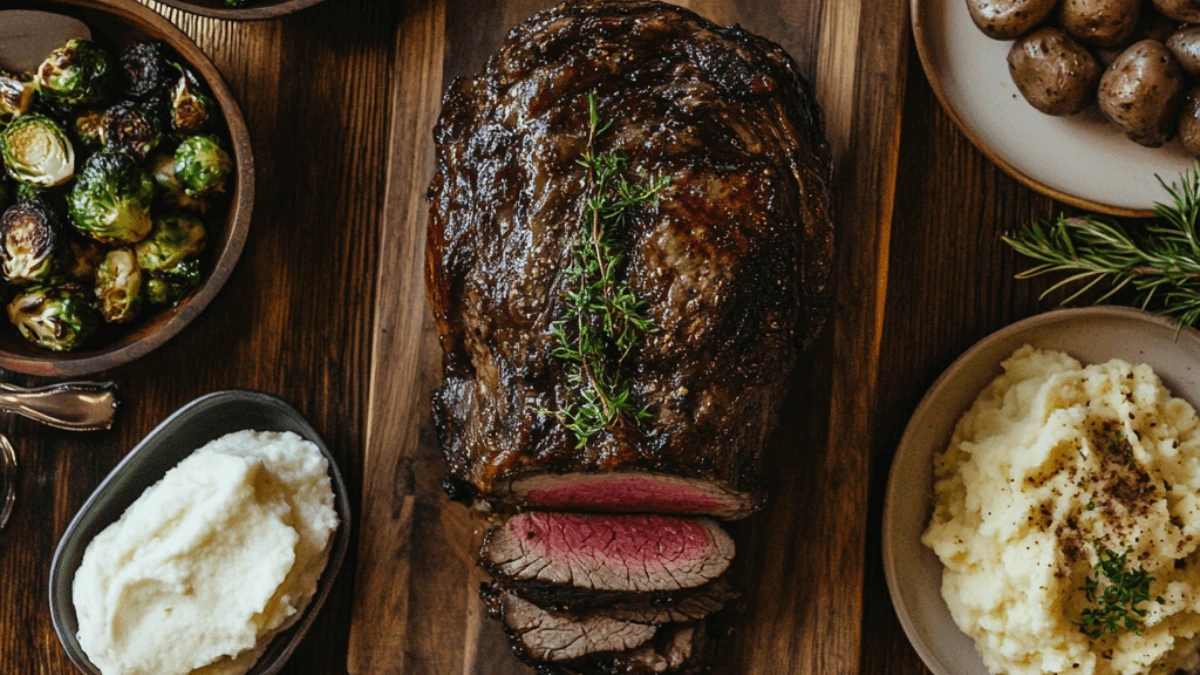Introduction
Why Ribeye Roast Is a Timeless Favorite
A ribeye roast is the epitome of classic comfort food, offering rich flavors, tender meat, and an elegant presentation. Whether you’re preparing a special holiday dinner or simply indulging in a hearty, satisfying meal, this cut of beef is sure to impress.
A Perfect Blend of Simplicity and Flavor
The beauty of a ribeye roast lies in its simplicity. With just a handful of ingredients and a little patience, you can create a show-stopping centerpiece that’s bursting with flavor.
The Secret to a Perfectly Cooked Ribeye Roast
Achieving Tender, Juicy Perfection
The secret to a perfectly cooked ribeye roast lies in the details. From selecting a high-quality cut of meat to mastering the cooking techniques, every step contributes to the final result. Letting the roast rest before slicing ensures it stays tender and juicy, while a golden-brown crust adds depth of flavor.
Balancing Flavor and Portion Control
Another key is slicing the roast into thin, even portions. This not only makes for a visually appealing presentation but also helps you manage servings and pair the dish with complementary sides like roasted vegetables or whole grains. A balanced plate lets the ribeye shine as the centerpiece without overpowering the meal.
Throughout this recipe, we’ll reveal more secrets and tips to ensure your ribeye roast turns out perfectly every time. Get ready to unlock the techniques that make this dish a timeless classic!

Step-by-Step Recipe Guide
Ingredients List with Exact Measurements
- 1 ribeye roast (3-5 pounds)
- 2 tablespoons olive oil
- 3 cloves garlic, minced
- 1 tablespoon kosher salt
- 1 teaspoon black pepper
- 1 teaspoon fresh rosemary, chopped
- 1 teaspoon thyme leaves
- 1/2 teaspoon smoked paprika
Detailed Instructions for Preparation
- Preheat the Oven
Preheat your oven to 450°F (230°C). While the oven heats up, allow the ribeye roast to come to room temperature for about 30 minutes. - Prepare the Roast
Pat the roast dry with paper towels. Rub it with olive oil, then season generously with salt, pepper, garlic, rosemary, thyme, and smoked paprika, ensuring the mixture coats the roast evenly. - Sear the Roast
Heat a large skillet over medium-high heat. Sear the roast on all sides until a golden-brown crust forms, locking in the juices. - Roast to Perfection
Place the seared ribeye on a roasting rack in a shallow pan. Roast in the preheated oven for 20 minutes, then reduce the temperature to 325°F (160°C) and cook until the internal temperature reaches 135°F (57°C) for medium-rare, about 1-1.5 hours. - Rest and Slice
Remove the roast from the oven and let it rest for at least 15 minutes. This allows the juices to redistribute, ensuring a tender, flavorful roast. Slice thinly and serve immediately.
Common Mistakes and How to Avoid Them For the Perfect Ribeye Roast
Choosing the Right Cut
To make a delicious ribeye roast, start by choosing a cut with good marbling. The fat melts during cooking, keeping the meat juicy and flavorful. Opt for a properly aged roast for better tenderness, and avoid lean cuts that may result in a dry roast.
Temperature Control
Preheat your oven to ensure even cooking. Use a meat thermometer to check the roast’s internal temperature. For medium-rare, aim for 135°F (57°C). Keep in mind, the roast will continue cooking after it’s removed from the oven, so pull it out slightly before reaching your target temperature.
Basting for Extra Flavor
Basting adds flavor and moisture to the roast. Spoon the juices from the pan over the roast every 30 minutes to enhance the flavor. Add fresh herbs like rosemary or thyme for an aromatic touch.
Use a Roasting Rack
A roasting rack helps cook the roast evenly by allowing heat to circulate all around it. It also lets the fat drip away, ensuring a crispy exterior. If you don’t have a roasting rack, you can use thick vegetable slices, like onions and carrots, to lift the roast.
Slicing the Roast Correctly
When slicing, cut against the grain to ensure tenderness. Slicing across the muscle fibers makes the meat easier to chew. A sharp carving knife will help you get clean, even slices.
With these simple tips, you’ll be able to cook a perfectly tender and flavorful ribeye roast every time!
Customizing Your Ribeye Roast
To elevate the flavor of your ribeye roast, consider adding a rub of Dijon mustard or a splash of red wine to the seasoning mix, giving it a gourmet twist. You can also experiment with a variety of herbs and spices, such as sage or oregano, to add depth and complexity to the roast. For a more unique flavor profile, try incorporating spices like cumin or coriander, which will bring an aromatic, savory touch that takes the roast to the next level.
Serving Suggestions
For a classic and well-rounded meal, pair your ribeye roast with creamy mashed potatoes, roasted Brussels sprouts, or a simple garden salad. These sides complement the rich flavors of the roast and create a balanced plate. Ribeye roast is also perfect for special occasions, whether you’re hosting a holiday gathering or an intimate dinner party. Its elegant presentation and delicious taste make it a crowd-pleasing centerpiece that will impress your guests and make any meal feel like a celebration.

Storing and Reheating Ribeye Roast
To keep your ribeye roast fresh, wrap leftovers tightly in foil or store them in an airtight container in the refrigerator for up to 3 days. When it’s time to enjoy the leftovers, reheat the slices gently in a skillet with a splash of beef broth or in the oven at a low temperature. This method helps maintain the moisture and flavor, ensuring the roast stays tender and juicy, just like when it was first cooked.
Frequently Asked Questions
What temperature should I cook a ribeye roast?
To cook a ribeye roast perfectly, start by preheating your oven to 450°F (230°C) to sear the outside of the roast. This initial high heat will create a delicious, golden-brown crust, locking in the juices. After the sear, reduce the oven temperature to 325°F (160°C) to finish cooking the roast evenly and slowly. This lower temperature ensures the meat cooks through without drying out. Keep an eye on the internal temperature, and remove the roast when it reaches your desired level of doneness. For Ribeye Roast Cooking Tips
How to Cook Ribeye Roast
How do I know when the ribeye roast is done?
The most reliable way to check if your ribeye roast is done is by using a meat thermometer. For a perfect medium-rare roast, the internal temperature should reach 135°F (57°C), while medium doneness requires 145°F (63°C). Keep in mind that the roast will continue to cook slightly as it rests, so it’s best to remove it from the oven a few degrees before reaching your target temperature to avoid overcooking.
Can I prepare a ribeye roast in advance?
Yes, you can prepare a ribeye roast in advance! Seasoning the roast the night before and storing it in the refrigerator gives the spices and herbs time to penetrate the meat, resulting in a richer, more flavorful roast. This not only enhances the taste but also saves time on the day of cooking. Just be sure to let the roast come to room temperature before cooking for even cooking and the best texture.
Conclusion
A ribeye roast is a timeless classic that combines rich flavors, tender meat, and effortless elegance. With the right preparation and attention to detail, you can create a dish that’s perfect for any occasion. Whether you’re serving it at a festive holiday dinner or a cozy family meal, this recipe is sure to impress. Get creative with seasonings, pair it with your favorite sides, and enjoy the delicious satisfaction of a perfectly cooked ribeye roast!

